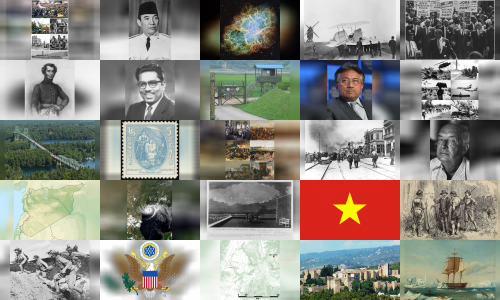#umayyad
Text
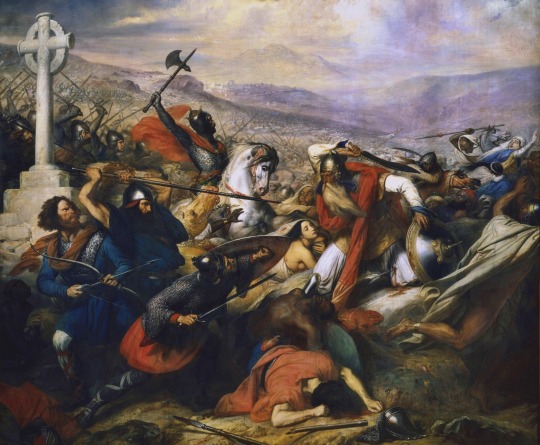
The Battle of Tours, October 732 by Charles de Steuben
#battle of tours#battle of poitiers#art#charles de steuben#umayyad#invasion#gaul#franks#frankish#charles martel#aquitainian#muslim#christian#history#europe#european#germanic#abdul rahman al ghafiqi#umayyad caliphate#france#western europe#christianity
61 notes
·
View notes
Photo

Mosaic depicting an etrog and knife
Hisham’s Palace (Khirbat al-Mafjar), Jericho
8th century
145 notes
·
View notes
Text
In the 8th century AD, a new power rose in the Middle East. Reigning for over five centuries the Abbasid Caliphate oversaw Islam’s Golden Age.
16 notes
·
View notes
Text

The Umayyad Mosque in Damascus, Syria
French vintage postcard
#vintage#tarjeta#briefkaart#postcard#damascus#photography#postal#syria#carte postale#sepia#ephemera#historic#mosque#french#ansichtskarte#postkarte#umayyad#the umayyad mosque#postkaart#photo
2 notes
·
View notes
Link
This is a good (easily accessible) introductory monograph on the Umayyads, especially for those unfamiliar with Islamic history. I don’t believe I’ve posted it here before. Enjoy.
15 notes
·
View notes
Text
The Reconquista & Moorish Resistance in Spain: Rebellion of the Alpujarras (1499-1501)
1492 was one of the most consequential years for the nationhood of what is now Spain. Not only was it the year Christopher Columbus & his crew reached the Americas in the name of the Spanish monarchs. An event that ignited the subsequent centuries long European exploration & conquest of the North American & South American continents. 1492 was also the year that most historians deemed the official end of the so-called Reconquista.
The Reconquista (reconquest) was also commonly viewed as a centuries long project of entailing conflict between the Christian kingdoms of the Iberian Peninsula (modern Spain & Portugal) aimed at “retaking” the land from the Islamic invaders who hailed from North Africa & the Middle East and ruled over large swaths of land collectively known as Al-Andalus. The grouping of Muslims in Iberia came to collectively be referred to as the Moors. As we’ll elaborate in this post, the Reconquista fitting into a binary Christian European versus foreign Muslim narrative is probably too narrow to accurately the describe the period in question. Nor as we’ll discuss later does the year 1492 automatically signal an end to the Moorish community such as it was within Iberia. As with much of history there is much more nuance to these topics. To get a more accurate picture of history requires accepting that nuance however inconvenient to our preconceived notions did in fact & does in fact exist in virtually every historical event recorded across the spans of time & space.
Let’s then define the rough time period we mean, when we discuss the Reconquista. Historians commonly refer to the Reconquista to be roughly from the year 718/722 AD/CE starting with the Battle of Covadonga lasting until the Fall of Granada in 1492 AD/CE. These are generally the bookends of Reconquista which are more or less accepted by historians today. For further context, let’s remind ourselves of what brought about the Reconquista & then discuss whether that it was a simple case of Christian vs. Muslim.
The Islamic Conquest of the Iberian Peninsula is generally believed to have begun in the year 711 AD/CE when a force of Muslims made up of mostly Berber or Amazigh (native peoples from North Africa) with some Arabs crossed the Straits of Gibraltar from modern Morocco & invaded modern-day Spain. This force was led by one Tariq ibn Ziyad (670 CE-720 CE). Tariq was a Berber from North Africa whose people had only within the last few decades come to embrace Islam & not completely. The early Islamic conquests spread rapidly following the death of the Prophet Muhammad in 632 CE. Muhammad had largely succeeded in uniting the Arabian Peninsula under Islamic rule by his death. From there under the first Islamic empire of sorts, the Rashidun Caliphate (632 CE-631 CE) saw conquests of both some of the Middle East and some of North Africa, namely Egypt from the Eastern Roman Empire (Byzantine Empire) & Iranian Plateau from the Persian Sassanian Empire. Following the First Fitna (civil war), the Rashidun Caliphate was succeeded following the death of Muhammad’s cousin & son-in-law Ali ibn Abi Talib, the 4th and final caliph of the Rashidun (rightly guided). They were succeeded by the Umayyad Caliphate (661 CE-750 CE), the 2nd major Islamic caliphate. The Umayyads were an Arab dynasty & distant relatives of Muhammad taking power after the First Fitna from their power base in Syria. They changed the trajectory of Islamic history in a number of ways. In a leadership level, they became the first hereditary Islamic dynasty, making the caliph less of a religious & political leader & primarily a political leader akin to a king or emperor in practice though nominally had the religious leadership attached to the title but this would decrease in practice overtime. The succession of caliphs were now passed essentially from father to son whereas the Rashidun caliphs were elected by a council called a shura who tried to assess the merits of the candidates proposed. Leadership was intended to be based on those whose character & ability would exemplify Islamic teaching & virtue as they believed the Prophet Muhammad had exhibited in his leadership.
The Umayyads greatly expanded the Islamic conquest to the whole of North Africa by the late 7th century & all the way into parts of Central Asia & the Indus Valley in modern Pakistan & India. They also extended northward into Byzantine held Anatolia (modern Turkey) and the southern Caucasus (Armenia). They further extended their reach into Europe with raids in the Mediterranean including the Iberian Peninsula by the late 7th & early 8th centuries CE. While Islamic teachings held that all Muslims were equal in terms of value regardless of ethnic or geographic background & the Umayyads did indeed rule over a vast multiethnic & multireligious empire, in practice they maintained a preference for Arab Muslims among the bureaucracy & aristocracy to rule over the empire. A hierarchy formed with the Arabs at top, non-Arab Muslims such as Persians, Egyptians, Greeks, Armenians & Berbers who recently converted as generally beneath the Arabs & below them Christians & Jews who did not convert to Islam along with other non-Abrahamic religions at the bottom of the hierarchy. Christians & Jews however were allowed to practice their religion without interference so long as the jiyza poll tax was paid to fund the caliphate’s operations in part.
It was under the Umayyad Governor of Ifriqiya “Africa” (modern Tunisia, Algeria & Libya) Musa ibn Nusayr, an Arab from Syria that Tariq ibn Ziyad was ordered to cross the Straits of Gibraltar & invade Iberia. At the time Iberia was under the control of the Kingdom of the Visigoths. The Visigoths were a Germanic people from Northern & Eastern Europe that moved nomadically into the Roman Empire during the late classical period into the early medieval period. They were among the so-called barbarian hordes that overran the western Roman Empire & had famously sacked Rome itself in 410 AD/CE. This contributed to the eventual downfall of the Western half of the Roman Empire. The Visigoths in time however along with other Germanic peoples like the Ostrogoths, Vandals & Franks began to adopt elements of Roman culture from the areas over which they now ruled. Picking up Latin as an official language & even adopting Christianity. The Visigoths had helped the Romans at one point fend off Attila the Hun and his nomadic empire in the plains of France. The Visigoths had settled in southern France before crossing into Spain where they overtook the Hispano-Roman population. The Hispano-Romans were a mixture of native Iberians, Celts, Carthaginian & Greco-Roman settlers among others in Iberia who more or less coalesced into a common people that spoke Latin & practiced a precursor to Catholic Christianity. Iberia likewise contained the native Basque peoples who maintained their own unique language & culture to this day, largely protected by their residence in the mountainous northern reaches of Iberia & southern France. The Visigoths ruled over them as powerful warrior minority who overtime increasingly assimilated into Hispano-Roman majority but still maintained serious differences. The brand of Christianity practiced by the Visigoths was known as Arianism & differed from the Christianity of Hispano-Romans. They also dealt with somewhat unsettled monarchical rules. Civil war occurred among the Visigoths for kingship which was not necessarily hereditary.
It is said that the rule of a Visigoth King by the name of Roderic who reigned from 710-711 was the impetus for the Muslim invasion. There is much debate about whether Roderic’s reign itself was the cause for the invasion as there is a fabled tale that he seduced or raped the daughter of one of his nobles who turned to the Muslims of the Umayyad Caliphate to act as a mercenary force to avenge & depose Roderic in exchange for conquest of the peninsula. This tale was sometimes accepted as fact but may actually be a tale or contain some elements of truth, the historical record to this day is limited on this. However, what seems to be known is that Roderic’s reign was not fully accepted by other Visigoth nobles within the kingdom & was disputed at best & perhaps ignited civil war or at least created a division that may have led to conspiracy between Visigoth nobles & Umayyads. Whatever the reality, the opposition to Roderic did create an opportune moment for an army of Berber and Arab Muslims (Moors) to land at the Rock of Gibraltar & begin their in-land push to begin conquering the Iberian Peninsula also known as Hispania. Gibraltar in fact takes its name from Tariq ibn Ziyad’s first name. In Arabic the rock which is the symbol of the modern British possession Gibraltar was known as Jabel-al-Tariq (Rock of Tariq), in antiquity it was known as one of the Pillars of Hercules. Roderic raised an army to oppose the Muslims and was defeated it is said due to betrayal of his own forces at Battle of Guadalete. This is turn opened a rapid conquest of virtually all of the peninsula within a decade. The Muslims received more Berber & Arab reinforcements and were more or less accepted by some of the Visigoths & Hispano-Roman population. The Umayyads had added the regions known in Arabic as Al-Andalus or land of the Vandals (Germanic peoples who reigned in Iberia earlier) as their western most province.
For virtually a decade their conquest went unimpeded due to the divisions among the Visigoths & the Hispano-Romans. However, the northern mountains of Hispania did protect some retreating Visigoth & Hispano-Roman Christians as it did their Basque neighbors. Creating a relative safe haven for them in the form of a new kingdom, the Kingdom of Asturias. Additionally, the Muslims had to now consolidate their hold over southern & central Iberia as well as the coasts. Further strains to the Islamic cause came in the form of division between Arab & Berber. The Arabs typically were new to North Africa much less Europe & due to Umayyad preferences were often given leadership positions & the greater spoils of war over the more numerous Berbers who acted as the rank & file soldier typically, leading to lingering resentment. These divisions would persist off and on throughout the history of Al-Andalus, notably in the Great Berber Revolt of 740-43. The Battle of Covadonga fought in either 718 or 722 CE saw the Asturians defeat the Umayyads for the first discernable time & allowed a check on their ambition to completely rule the peninsula. Other setbacks to Muslim conquests came in their invasions of France where in 721 they were defeated in the Siege of Toulouse & in 732 the Franks decisively defeated the Muslims at the Battle of Tours.
In 750 CE, the Umayyads were overthrown by a new Arab dynasty with closer blood ties to the Prophet Muhammad, the Abbasid dynasty. The Abbasid Caliphate (750-1258 & 1261-1517) were descended from the Prophet’s uncle & while they maintained the Umayyad preference for hereditary succession to the caliphate, they reversed the Umayyad preference for an Arab only bureaucracy, largely using Persians to fill government roles & allowing other non-Arabs likewise to fulfill leadership roles. The Abbasids would likewise preside over an age of cultural flowering within the Islamic world, the so-called Islamic Golden Age with the establishment of Baghdad in Iraq as their capital. They’d rule over the largest Islamic empire in history but one not entirely united as they would soon lose Al-Andalus.
The Abbasids would try to kill every remaining Umayyad but one named Abd Al-Rahman Al-Dahkil (the Entrant) managed to escape Syria while witnessing his brother’s execution. Abd Al-Rahman’s father was Arab but his mother was Berber & he sought refuge among his mother’s relatives in North Africa which had become relatively autonomous under the Umayyads due to the rule of another Arab noble dynasty known as the Fihrids. They accepted Abd Al-Rahman’s exile within their borders as they themselves were not eager to accept Abbasid rule & did so nominally. The Fihrids had spearheaded the Arab conquest of North Africa & now ruled as governors of Al-Andalus well into the 8th century but divisions amongst the Yemeni & Syrian Arab factions and Berber factions created an opportune moment for Abd Al-Rahman to make his way into Iberia. There with an army of Syrian Arabs & Berbers he defeated the Fihrid governor of Al-Andalus. In turn he now created an independent Emirate (Principality), the Emirate of Cordoba (756 CE-929CE) which later evolved into the independent and rival Caliphate of Cordoba (929 CE-1031 CE). The Umayyad direct rule over Cordoba likewise saw a cultural flowering which rivalled that of the Abbasids in Baghdad. With geography & other more pressing issues closer at home, the Abbasids de-facto accepted the Umayyad reign over Al-Andalus. This peaked under the reign of Abd Al-Rahman III who reigned as Emir from 912-929 before declaring himself as Caliph of Cordoba and ruling as caliph from 929 to 961. Cordoba became a major center of learning in Western Europe & both as an emirate & caliphate saw much knowledge transfer between Muslim, Christian & Jews. These people could live side by side but by the 10th & 11th centuries CE, the majority population of the Iberian Peninsula was in fact majority Muslim. This populace became collectively known as the Moors to the Chrisitan European world.
What constituted the term Moor? It is derived from the term Mauri originally derived from the Greek term for the Berber tribes of northern Morocco & Algeria, that term was Maurusii or Mauri as it was adopted in Latin later by the Romans after their conquest of North Africa. It also applied to the Latin name for the province of Mauretania. Originally it applied to the Berber peoples of this region, but this preceded the Islamic era by centuries & had no religious connotations. By the time of Al-Andalus, Mauri remained the Latin term for the Berbers but the Muslims were never strictly only Berbers but a combination of Berber & Arabs. The term Moor in English is in turn derived from the Latin daughter Romance languages of Spanish, Italian & French which used the term moro & maure. By the time of Al-Andalus as the Caliphate of Cordoba, Moor was applied to all Muslims within the Iberian Peninsula. This applied equally to Berbers, Arabs & European converts to Islam, the Hispano-Romans & Visigoths also to some degree converted to Islam, as did slaves imported from Eastern Europe via the Arab slave trade. These latter two groups (Hispano-Romans & the Slavic slaves) helped constitute the majority of Iberia’s previously Christian population & it was through this conversion that Islam became the predominant religion of Iberia during much of the Middle Ages. They were known as muwallad.
Moors never truly constituted a specific ethnicity in Spain & Portugal. It was perhaps better described as a cultural or religious designation rather than an ethnic or racial one. Moors came from various ethnic backgrounds spanning 3 continents (Europe, West Asia & North Africa) and could range in skin color from dark to light & fair skinned as it was not a racial designation. Furthermore, the racial divides between Berber & Arabs during the earlier Al-Andalus period began to dissipate gradually over the centuries due to intermarriage between the two communities & this also included muwallad (Hispano-Roman) marriage with Berber & Arab communities as well. In time leading to a community that became better known as Andalusian (taken from Al-Andalus) or to the Christians as Moors.
As the Islamic power changed overtime from emirate to caliphate likewise new Christian kingdoms arose from the north of Iberia. Asturias gave way to the Kingdom of Leon & the Basques formed the Kingdom of Pamplona. In time the kingdoms of Castile & Aragon formed & Pamplona turned into the kingdom of Navarre. As the Reconquista progressed the political interplay between Christian & Muslim powers became complex & despite the common narrative of a strict Christian vs. Muslim conflict much like the Crusades of the Middle East from the late 11th century onward, a more nuanced reality existed. The caliphs of Cordoba were in fact mostly European being only patrilineal descendants of the Arab Umayyads. Their mothers were made up of generations of either European slaves taken in raids or in some cases the Basque & Hispano-Roman royalty of the northern kingdoms who made treaties with the Umayyads & sometimes sent their daughters or sisters to become wives of the emirs & caliphs so as to ensure peace between their respective kingdom. Abd Al-Rahman III, Caliph of Cordoba was the grandson of a princess from Pamplona & great-grandson of the Basque king of Pamplona. He was said to have had fair skin & light eyes & hair/beard which he dyed black to make it appear more “Arab” despite that three-quarters of his grandparents were completely European, the remaining quarter was partially Arab intermixed with European captives in the emir’s harem. Subsequently his cousins constituted the fellow monarchs of northern Iberia he had to contend with both through war & diplomacy.
Throughout the Reconquista era, interaction between Christian & Muslim occurred at all levels in Iberia. Trade, commerce, art, education & cultural exchange was not uncommon in addition to the familial ties of politicians & the ever-shifting alliances. Christian powers were in competition with each other & Al-Andalus, matters complicated further following the collapse of the Caliphate of Cordoba which saw the break apart into numerous Muslim petty kingdoms called taifas. Some ruled by Arab, Berber or muwallad dynasties. Some paired with Christian powers against rival Muslim powers & likewise Christian powers teamed with Muslim powers against fellow Christian powers but the fractured nature of the taifas gave opportunity for Christian kingdoms like Castile & Aragon to gradually take more territory. This was encouraged by the papacy in Rome and other players in Western Europe which sometimes saw French, English and other European mercenaries serve in the Iberian Christian armies against the Muslims. So, it’s not inaccurate to say the Reconquista contained elements of a Christian vs. Muslim narrative & indeed it was a goal of many if not all Christian rulers in Iberia to drive the Muslims ultimately out of Iberia & unite the lands under their own rule, but their ambitions also extended to leadership over their fellow Christians too. The question was would achieve this.
Before this could happen, intervention from Morocco took place with a Berber led religious movement/dynasty known as the Almoravids intervened in Iberia & defeated a Castilian & Aragonese combined force at the Battle of Sagrajas in 1086. They had been invited by the taifa rulers of Al-Andalus who realizing their own power slipping due to their infighting & subsequent losses to the Christian north needed a united front against complete collapse. The Almoravids indeed halted the Reconquista but in the 12th century as home in Morocco they were supplanted by yet another Berber religious movement & dynasty, the Almohads. The Almohads not only took over Morocco but much of North Africa & eventually Al-Andalus. Likewise, they had to compete with Christian powers and the remaining taifas of Iberia more or less determined to maintain some autonomy.
However, the tide seemed to forever turn in the Christian favor following the 1212 CE Battle of Las Navas de Tolosa in which a Christian coalition of Castile, Aragon, Navarre and a host of Crusader military orders & mercenaries from throughout Western Europe defeated the Almohads decisively. This subsequently saw the Almohads eventually collapse in Iberia while they likewise power to various dynasties in North Africa spanning from Morocco to Libya. The third taifa period in Iberia came after the Almohad collapse. This likewise saw the taifas being subsumed by the Christian kingdoms. The one relatively strong Muslim power to remain in Iberia was a relatively new one which became the Emirate of Granada (1230 CE-1492 CE).
Granada had the Sierra Nevada mountains to offer it a modicum of defense from the Christian north & its ruling dynasty, the Nasrids were of Arab stock. The Nasrids two lasting contributions would be in architecture & historical placement. Their architecture was best exemplified in the form of the world famous Alhambra palace complex. Which served as a fort & series of palaces built on a hill overlooking Granada that saw expansion over the coming centuries. The Nasrids unfortunately for the Muslims of Iberia were known in history as the rulers of the last independent Muslim realm in Western Europe. As time went on they became vassals of the Kingdom of Castile, the most powerful & leading Christian realm in Iberia. They alternated between war & peace with Castile, inflicting defeat & suffering defeat to the Castilians a gradual loss of territory to the Christians became irreversible & more and more the Muslims of Iberia of Berber, Arab & muwallad background rallied around their religious & cultural identity, becoming more culturally & geographically Andalusian as ethnic identifiers continued to wane in importance. Granada’s ever shrinking borders became the last safe haven for the free practice of Islam in Iberia, something that had lasted for nearly 800 years.
1491-1492 would see the Emirate of Granada come to end, along with it a successful completion of Reconquista and the end of Muslim rule in Iberia for all time up to the present. The Catholic Monarchs, Isabella I of Castile & her husband Ferdinand II of Aragon created a personal union between the two most powerful kingdoms in all Iberia. Their marriage also saw a renewed joint focus on ending Granada with the idea of removing the last Muslim power in the peninsula. Starting in 1482 Castile & Aragon fought a decade long war with Granada but it was the siege of Granada itself in 1491 that caused Muhammad XII, the Nasrid emir of Granada to surrender the city, the whole of the emirate & the Alhambra palace built by his ancestors to Isabella & Ferdinand. Christian success came when the besieging forces bombarded the city with early gunpowder artillery & cutoff the water supply & demoralized the Muslim defenders. Additionally, there was rampant bribery going on between both sides which added an air of confusion & distrust between peoples within & outside of Granada. Finally, the terms offered by the Catholic Monarchs to Muhammad XII caused him to capitulate as they were deemed generous to the Muslims of Granada & this was preferable to complete death & destruction.
The Treaty of Granada signed in November 1491 gave a truce that stated on January 2nd,1492 the city would be handed over to the Christians effectively ending the Reconquista. The treaty had many articles but largely can be summed as saying the Muslims of Granada in exchange for their submission to Isabella & Ferdinand would be able to essentially keep their property & maintain their free practice of religion & custom with little or no interference.
While this officially ended the Reconquista, it also helped give birth to the modern nation of Spain as Spanish nationhood became a more discussed notion following the fall of Granada. The Alhambra was eventually converted into a Christian palace, particularly under Isabella & Ferdinand’s grandson’s (Charles V, Holy Roman Emperor) reign.
Initially, these generous terms afforded to the Muslims of Granada from their new sovereigns was adhered to but for both Jews & Muslims in Spain, the subsequent Spanish Inquisition by the Catholic Church would lead to massive disruptions. However, their remained a difference of opinion between the church and the monarchs. Church officials wanted the state to apply pressure to the Muslims & Jews of the kingdom with an eye towards conversion en masse. Meanwhile, the king & queen sought to uphold the terms & let the Muslims passively convert to Christianity if possible. In 1499, during their visit to Granada the population (many Muslim) actually cheered the crown for nearly a decade of respectfully adhering to the provisions of the treaty in 1491.
This rapidly changed that same year when the Archbishop of Toledo moved to Granada & begin asking for the imprisonment of Muslims including the nobles. Once in prison they faced torture until conversion. Spurred on by this the Archbishop begin to increase the pressure by having a loophole in the trearty allow for the questioning of Christians who had become Muslim converts & done so in front of Muslim clerics. These converts were summoned to prison for questioning & often women were targeted which angered their Muslim male relatives. This reached a breaking point when one convert woman openly decried she was being forced to convert to Christianity, the officials escorting her to prison were surrounded by a Muslim crowd, one was killed while the other escaped & this in turn triggered an open revolt.
The archbishop demanded the Muslims hand over the killers of his agent which failed. Instead, he called up soldiers to help provide a show of force if necessary to put down the revolt. After negotiation the killers were turned over the rebellion died down due Muslims handing over their weapons. Nonetheless the archbishop was recalled to Seville by Ferdinand who was angered. The archbishop nevertheless convinced him that Muslims broke the treaty through their open revolt. Furthermore, he managed to get the Catholic Monarchs to pardon all rebels in exchange for their conversion to Christianity. This conversion was nominal for the whole Muslim populace of Granada.
While Granada’s Muslims calmed their own rebellion down through negotiation, the rebel attitude spilled over to the countryside. Particularly into the Alpujarras mountain range south of Granada. There the Andalusian Muslims were living fairly free lives devoid of much interference & enforcement of the treaty. Fearing the forced conversions that befell Granada, they declared the revolt in the name of preserving their religion & culture. Due to the mountainous terrain & well led tacticians, they were able muster up a guerrilla warfare campaign against Christian rule. However, the Christians were able to send roughly 80,000 soldiers into the region to put down the rebellion eventually with Ferdinand overseeing the war efforts. The Muslim guerillas lacked an organized structure of command & overall strategy & this in turn allowed the Christian forces to defeat the rebels piecemeal. Rebel lives could be spared on the condition of conversion to Christianity. Furthermore, the Christian forces now took to preserving little to no quarter to the enemy. In the town of Laujar de Andarax 3,000 Muslims were killed included hundreds of women & children blown up in a mosque in which they sought refuge due to ignited gunpowder supplied to besiege the town. By early 1501, Ferdinand declared the rebellion over. The Muslims continued to rebel & they were met with both defeat & victory but realizing they could not have a great chance at winning the war without a defined command & strategy, they sued for peace. Ferdinand likewise felt the peace was needed since his army couldn’t sustain the logistical challenges of a long-drawn-out guerilla war in the mountains.
The terms of Ferdinand’s accepting the Muslim’s surrender was no longer the generous terms of 1491 a decade before. The rebels must convert through baptism, reject baptism & face death or enslavement or finally choose exile outside of Iberia. The cost of exile was to be self-funded too & for many, it was far too expensive & extortionate for the average Andalusian Muslim. This left few any decision but to remain & nominally convert. All Muslims in Granada were in name Christian if in practice they continued to defy the laws they now were forced to follow. Many continued to practice Islamic customs in secret, but they were able to maintain their Islamic dress & some would still speak Arabic & maintain other customs. The enforcement by the Christian authorities was stricter than before the rebellion but it was not always feasible, especially in the mountainous Alpujarras. They publicly professed to be Christians but were determined in many cases to remain Muslim despite the threat of death which hung over them. These lingering tensions & suspicions by the subsequent Spanish monarchs & the church led to increased scrutiny & enforcement in the form of dress codes, inquisitions into the sincerity of their conversion & harsh punishment for those found to violate the new royal proclamations. By now, the Muslims in Iberia were referred to as Moriscos in Spanish, which translates as “little Moors” & applied to these Spanish Muslims who now professed to be Christian through conversion but still secretly practiced Islam & maintained Islamic traditions in private. For the Moriscos, the tension between state & mosque was eventually going to be too much to withstand. Events would boil over into a second and even larger rebellion later in the 16th century one which would determine the fate of Iberian Moors for centuries to come...

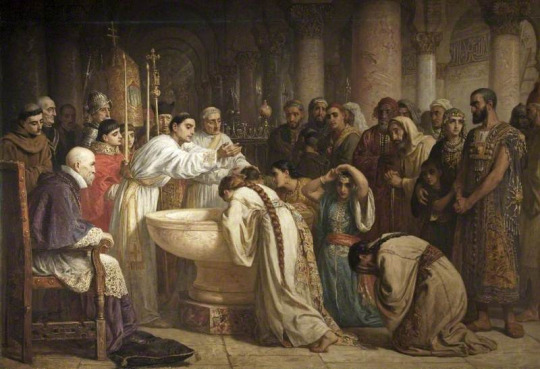
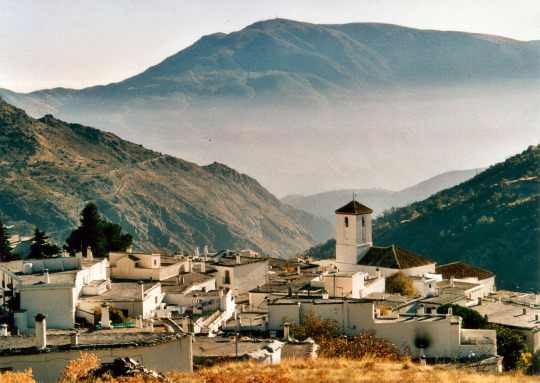
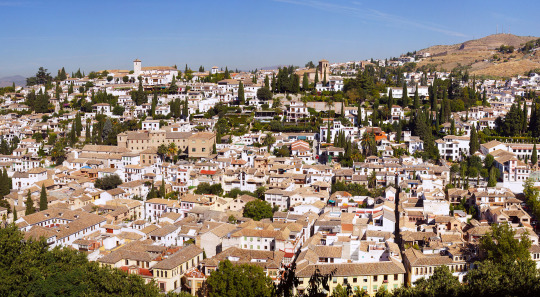
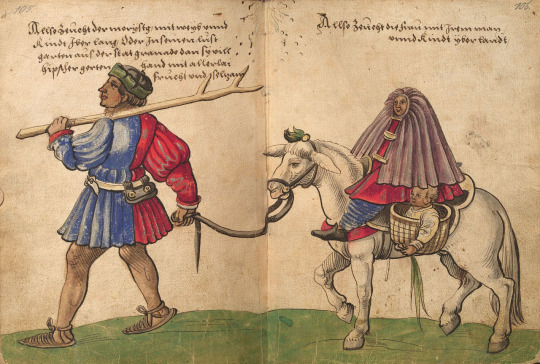
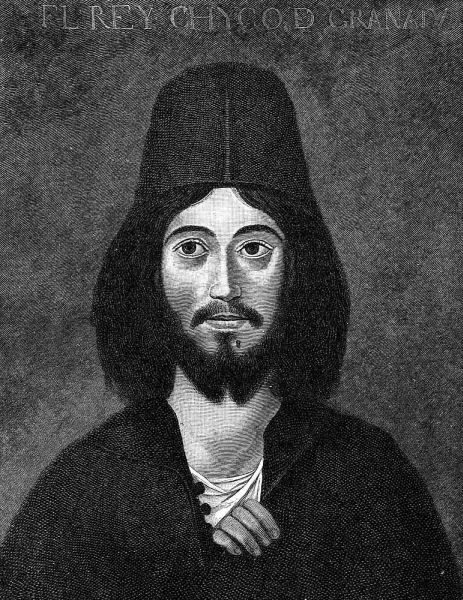
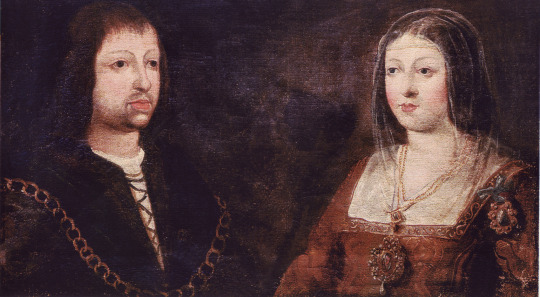
#Moors#morisco#spain#islamic history#islam#spanish inquisition#castile#aragon#portugal#navarre#granada#Emirate of Granada#cordoba#umayyad#Al andalus#military history#alpujarras#Guerilla Warfare#Middle Ages#reconquista#caliphate of cordoba#abbasid#catholic monarchs#ferdinand ii#isabella i of castile#1492#christopher columbus#morocco
5 notes
·
View notes
Text
On this day (26 December, 1489 CE {22/23 Muharram, 895 AH}), the Andalusian city of Almería fell to the joint monarchy of Castile and Aragon that would later become Spain.
The city was founded by the famous Umayyad Emir of Córdoba and later the first Umayyad Caliph of Córdoba, Abdur-Rahman III, in the year 955 CE.
Its Muslim population was almost entirely composed of indigenous (Iberian) converts to Islam, who were later joined by southern Arabian (Yemeni) tribes who settled in the region.
Pictured is the Alcazaba of Almería (Alcazaba de Almería/Citadel of Almería) which was founded by the aforementioned Abdur-Rahman III, and which gave this city its name: "al-Mariyyah" or "the Watchtower".
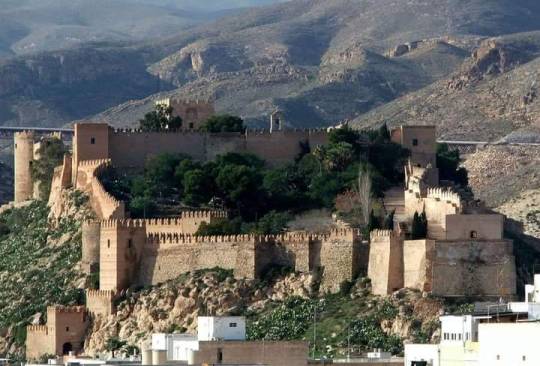
#islam#muslim#history#islamic history#history blog#umayyad#spaintravel#spain#almeria#almería#al andalus#andalusia#andalus
5 notes
·
View notes
Text
The Multiethnic Origins of the Muslim Conquest
The Multiethnic Origins of the Muslim Conquest
Episode 19: Islam and the Caliphates
Barbarian Empires of the Steppes (2014)
Dr Kenneth Harl
Film Review
In this lecture, Harl focuses mainly on the battle for control of the Muslim caliphate following the birth of Islam in the 7th century AD.
The key dates he cites are
622 AD – the prophet Muhammad migrates to Medina from Mecca owing to conflict with Mecca elites.
632 AD – Muhammad dies after…
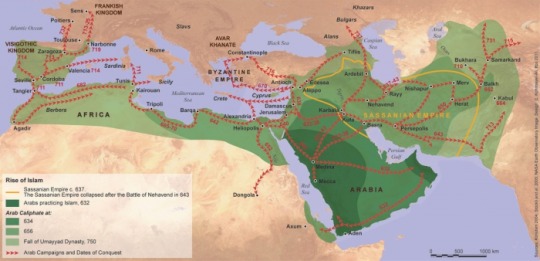
View On WordPress
#abbasid#ali#baghdad#byzantine#caliphate#damascus#egypt#fatima#indus valley#khazars#levant#mecca#media#muhammad#north africa#sassanid empire#shia#transoxiana#turks#umayyad
9 notes
·
View notes
Text
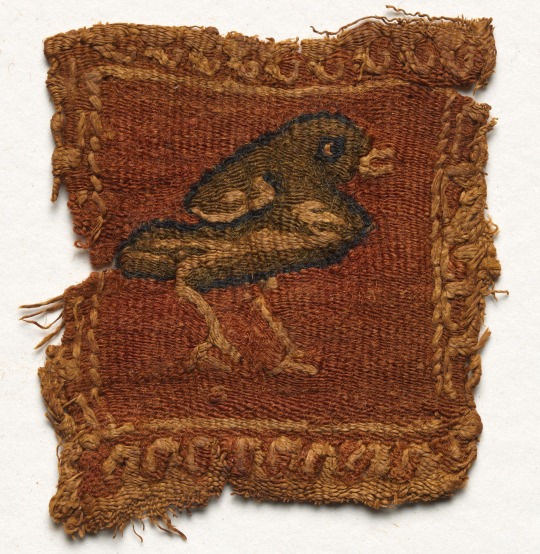
Fragment with Roundel and Decorative Stripes, 600s - 700s. Egypt, Umayyad period (661–750).
1 note
·
View note
Text
Embark on a riveting journey through the pages of history as we unravel the extraordinary saga of the Abbasid Caliphate – a majestic empire that soared to unimaginable heights during the Islamic Golden Age. From the bloodthirsty Abu Abbas as-Saffah, the first caliph of the Abbasid Caliphate, to the legendary Harun al-Rashid, whose cultural brilliance has turned him into the most famous of the Abbasid rulers.
This epic tale spans over 500 years of ascendancy, unraveling and resilience. Experience the cultural renaissance under the visionary Harun al-Rashid, who dreamt of making the Abbasid Caliphate a global center for arts and learning. The establishment of the Grand Library of Baghdad, the House of Wisdom, became a beacon for knowledge preservation. However, as we delve deeper, witness the political intrigues, civil wars and the inevitable decline leading to the poignant end of an era.
The epic tale concludes with the tragic fall of Baghdad in 1258, marking the end of the Abbasid Caliphate. Yet, the legacy lives on, leaving an indelible mark on science, philosophy, and the arts, echoing through the corridors of time.
7 notes
·
View notes
Text
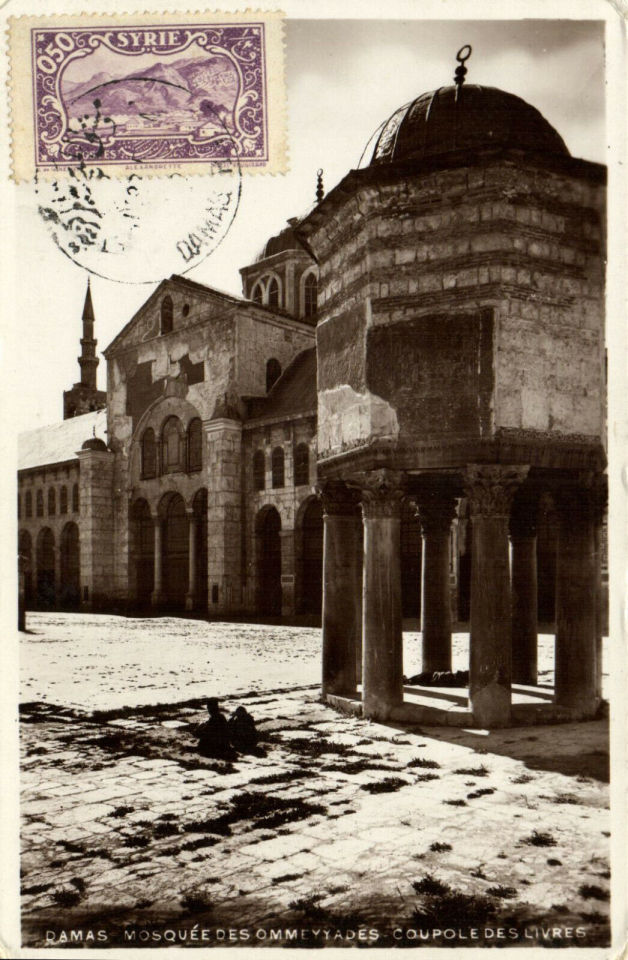
The Umayyad Mosque in Damascus, Syria
French vintage postcard, mailed in 1933
#postkaart#the umayyad mosque#syria#carte postale#french#briefkaart#old#sepia#postkarte#vintage#postal#damascus#photography#mailed#ephemera#umayyad#mosque#postcard#tarjeta#photo#1933#ansichtskarte#historic
1 note
·
View note
Text
Al-Khadir b. Tamim charged (Nasr’s men) wearing a coat of mail, and they shot arrows at him. Then Hubaysha, a mawla of Nasr, dashed at him, and wounded him in the throat. Al-Khadir tore the spearhead from his throat with his left hand and his horse set off with him. He charged Hubaysh, speared him, and threw him off his horse, and al-Kirmani’s foot-soldiers finished him off with clubs.
Al-Khadir encountered Salm b. Ahwaz, took a mace from his nephew and clubbed Salam and wrested him off his horse. Two men of Tamim charged Salm, but he got away, and threw himself from the bridge. He had sustained some ten blows in his iron helmet, and he collapsed. Muhammad b. al-Haddad carried him to Nasr’s camp, and the forces withdrew.
[a few days later] Al-Khadir b. Tamim attacked Salm b. Ahwaz and speared him, but he deflected the blow. Then al-Khadir struck him on the chest with an iron bar, and again on his shoulder. He struck him a third time on his head and Salm fell down.
Salm was then saved by Nasr and more horsemen it seems.
0 notes
Photo

History Births on July 20
0 notes

